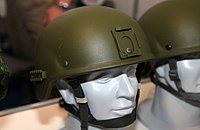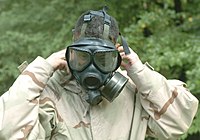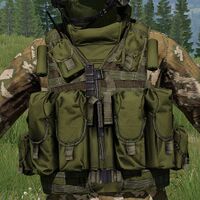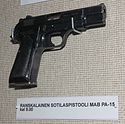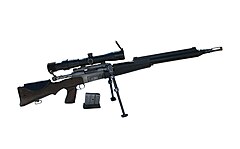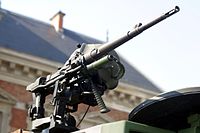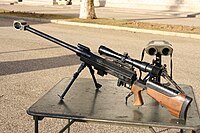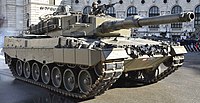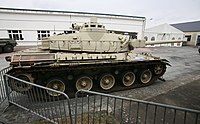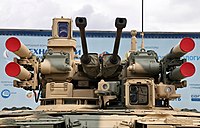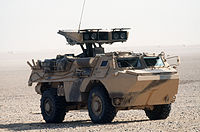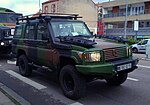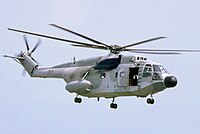United Communes Defense Forces: Difference between revisions
mNo edit summary |
mNo edit summary |
||
| Line 11: | Line 11: | ||
| caption2 = | | caption2 = | ||
| motto = | | motto = | ||
| founded = {{Start date and age| | | founded = {{Start date and age|1836|df=yes}} | ||
| current_form = | | current_form = {{Start date and age|1922|df=yes}} | ||
| disbanded = | | disbanded = | ||
| branches = [[File:BlackNode.svg|23px]] [[Talaharan Army Corps|Army Corps]]</br>[[File:BlackNode.svg|23px]] [[Talaharan Navy Corps|Navy Corps]]</br>[[File:BlackNode.svg|23px]] [[Talaharan Air Corps|Air Corps]]</br>[[File:BlackNode.svg|23px]] [[Black Guard Corps (Talahara)|Black Guard Corps]] | | branches = [[File:BlackNode.svg|23px]] [[Talaharan Army Corps|Army Corps]]</br>[[File:BlackNode.svg|23px]] [[Talaharan Navy Corps|Navy Corps]]</br>[[File:BlackNode.svg|23px]] [[Talaharan Air Corps|Air Corps]]</br>[[File:BlackNode.svg|23px]] [[Black Guard Corps (Talahara)|Black Guard Corps]] | ||
| Line 66: | Line 66: | ||
==History== | ==History== | ||
The Black Guards of Talahara emerged as one of the major revolutionary factions during the [[Talaharan Revolution]]. In 1836, sympathetic elements of the Royal Talaharan Army defected to the Communard cause after the execution of the Assembly of Chiefs and formed the Central Commune Army. However, the majority of Communard fighters were untrained, local militias who took up the black banner of the revolution. So-called Black Guards were decentralized, organized at a local level, and coordinated democratically. As the conflict progressed, most units relied on directives or services directly offered to the Commune Council. | |||
At the conclusion of the Revolution, the Central Commune Army was disbanded owing to concerns that it could exert undue influence over the nascent Talaharan Commune. The Black Guards remained the only military body of the Commune until the consolidation of the Talaharan Navy in 1845. Both the Black Guards and the Talaharan Navy were renamed the Black Guard Corps and the Talaharan Navy Corps, respectively, in 1853. In 1854, the Talaharan Army Corps was founded as a professional standing army to supplement the Black Guards, largely as a response to tensions over the Protectorate of Tarshish which remained occupied by [[Yisrael]] since the Talaharan Revolution. | |||
The first major direct operation conducted by the Talaharan Army Corps was the Annexation of Amara, known as the Invasion of the Timna Strip in Yisrael. Seizing on the weakness of the Kingdom of Yisrael in the direct aftermath of the [[West_Scipian_Wars#Second_West_Scipian_War_.281915-1918.2|Second West Scipian War]], Talaharan forces quickly invaded and consolidated control over Amara, an oil-rich region that was home to a population of Kel Hadar and Kel Tenere peoples living under Yisraeli rule. The rapid invasion was a major success, with few engagements or casualties before the region was formally conceded. While Talahara was regarded at the time as an entrenched syndicalist fortress-state, contemporary foreign analysts had largely dismissed the Commune's power to project and the ability of its professional forces. | |||
Developments in airpower beyond reconnaissance aircraft and dirigibles led to the creation of the Talaharan Air Corps in 1922. | |||
==Structure== | ==Structure== | ||
| Line 82: | Line 89: | ||
| CC-T84/B2 | | CC-T84/B2 | ||
| [[File:6B47 helmet - InnovationDay2013part1-56.jpg|200px|center]] | | [[File:6B47 helmet - InnovationDay2013part1-56.jpg|200px|center]] | ||
| {{flag| | | {{flag|Talahara}} | ||
| Helmet | | Helmet | ||
| | | | ||
| Line 436: | Line 443: | ||
===TCDF Navy Corps=== | ===TCDF Navy Corps=== | ||
===TCDF Air Corps=== | ===TCDF Air Corps=== | ||
==Ranks and insignia== | ==Ranks and insignia== | ||
Revision as of 21:14, 26 February 2022
This article is incomplete because it is pending further input from participants, or it is a work-in-progress by one author. Please comment on this article's talk page to share your input, comments and questions. Note: To contribute to this article, you may need to seek help from the author(s) of this page. |
| Talaharan Commune Defense Forces | |
|---|---|
| ⵉⵛⴰⵛⵀⴰⵜⵉⵏ ⵉ’ⵀⴰⵔb ⵏ'ⵊⴰⵎⴰⵖⴰ ⵏ'ⵜⴰlⴰⵀⴰⵔⴰ Išašhatin I’Harb N'Jamaɣa N'Talahara | |
| Founded | 1836 |
| Current form | 1922 |
| Service branches | |
| Headquarters | Tiɣremt Building, Maktarim, Talahara |
| Leadership | |
| Commander-in-Chief | Executive Council |
| Defense Committee Chair | General Tafsut Amalu |
| Personnel | |
| Military age | 18-55 |
| Conscription | Voluntary service only |
| Active personnel | 259,670 total: Army Corps: 100,080 Air Corps: 25,100 Navy Corps: 14,990 Black Guard Corps: 119,500 |
| Expenditure | |
| Budget | $34.79 billion |
| Percent of GDP | 2.04 |
| Industry | |
| Foreign suppliers | |
The Talaharan Commune Defense Forces, (TCDF; Takelat: Išašhatin I’Harb N'Jamaɣa N'Talahara; ⵉⵛⴰⵛⵀⴰⵜⵉⵏ ⵉ’ⵀⴰⵔb ⵏ'ⵊⴰⵎⴰⵖⴰ ⵏ'ⵜⴰlⴰⵀⴰⵔⴰ) are the unified armed forces of the Talaharan Commune. The TCDF is made up of four components: the Army Corps, Air Corps, Navy Corps, and the Black Guard Corps. The TCDF is headed by the Executor of Defense of the Executive Council and governed by the Defense Committee, a group of senior military representatives and civilian oversight agents.
The legally authorized maximum size of the TCDF is 275,000 members across all four components. In practice, the total size is less than 260,000 members. The three main professional components are the Army, Air, and Navy Corps. The Black Guard Corps is an irregular force of local militias. While ostensibly independent, the Black Guards are trained by and coordinate with the Army Corps.
History
The Black Guards of Talahara emerged as one of the major revolutionary factions during the Talaharan Revolution. In 1836, sympathetic elements of the Royal Talaharan Army defected to the Communard cause after the execution of the Assembly of Chiefs and formed the Central Commune Army. However, the majority of Communard fighters were untrained, local militias who took up the black banner of the revolution. So-called Black Guards were decentralized, organized at a local level, and coordinated democratically. As the conflict progressed, most units relied on directives or services directly offered to the Commune Council.
At the conclusion of the Revolution, the Central Commune Army was disbanded owing to concerns that it could exert undue influence over the nascent Talaharan Commune. The Black Guards remained the only military body of the Commune until the consolidation of the Talaharan Navy in 1845. Both the Black Guards and the Talaharan Navy were renamed the Black Guard Corps and the Talaharan Navy Corps, respectively, in 1853. In 1854, the Talaharan Army Corps was founded as a professional standing army to supplement the Black Guards, largely as a response to tensions over the Protectorate of Tarshish which remained occupied by Yisrael since the Talaharan Revolution.
The first major direct operation conducted by the Talaharan Army Corps was the Annexation of Amara, known as the Invasion of the Timna Strip in Yisrael. Seizing on the weakness of the Kingdom of Yisrael in the direct aftermath of the Second West Scipian War, Talaharan forces quickly invaded and consolidated control over Amara, an oil-rich region that was home to a population of Kel Hadar and Kel Tenere peoples living under Yisraeli rule. The rapid invasion was a major success, with few engagements or casualties before the region was formally conceded. While Talahara was regarded at the time as an entrenched syndicalist fortress-state, contemporary foreign analysts had largely dismissed the Commune's power to project and the ability of its professional forces.
Developments in airpower beyond reconnaissance aircraft and dirigibles led to the creation of the Talaharan Air Corps in 1922.
Structure
TCDF Army Corps
Equipment
| Model | Image | Origin | Type | Notes |
|---|---|---|---|---|
| CC-T84/B2 | Helmet | |||
| CC-XO59/A2 | Gas mask | |||
| JC-T85/B1 | Combat vest | |||
| PC-T66/A | Camouflage | Arid digital camouflage | ||
| PC-T66/B | Camouflage | Temperate digital camouflage |
Small arms
| Model | Image | Origin | Type | Calibre | Notes |
|---|---|---|---|---|---|
| Small arms | |||||
| FA-CR46/A2 Rzawl |
Assault rifle | 7.5×35mm | Standard service rifle | ||
| FR-X(O-NO)23/B3 Asmawi |
Battle rifle | 7.5×54mm | Former service rifle, in reserve | ||
| PA-M35/A2 Isk |
Pistol | 9×20mm | Standard service pistol | ||
| PR-M62/A3 | Revolver | 9×33mmR 9×20mm |
Provided after a decade of service, in limited use with special forces | ||
| FR-M05/C1 Lafliš |
Precision rifle | 7.5×54mm | Standard precision rifle | ||
| PM-M32/B1 Imik |
Submachine gun | 9×20mm | |||
| FM-M21/A3 Stulskabus 8 |
Medium machine gun | 7.5×54mm | Section support weapon and vehicle-mounted machine gun | ||
| FM-M03/A3 Stulskabus 13 |
Heavy machine gun | 13×96mm | Vehicle-mounted machine gun | ||
| FRCM-M70/A1 | Anti-matériel rifle | 13×96mm | In limited use with special forces | ||
| AS F13 | Semi-automatic rifle | 7.5×54mm | Former service rifle, in ceremonial use | ||
| AS F5 | Bolt-action rifle | 7.5×54mm | Former service rifle, in ceremonial use, conversion to precision rifles | ||
| LG-M58/A1 Issoufir |
Grenade mortar | 50mm | |||
| G-XNO20/A1 Dikra |
Hand grenade | ||||
Vehicles
| Model | Image | Origin | Type | Armament | Notes |
|---|---|---|---|---|---|
| Armoured vehicles | |||||
| CB-A77/A2 Mirage |
Third generation main battle tank |
|
Co-developed with the Ostrozavan BTv.78 series, the North Ottonian M15/VII series, and the Tsurushiman Type 90 | ||
| CB-A20/C3 Lancier |
Second generation main battle tank |
|
|||
| CS-A20/F2 Arbaléte |
Fire support vehicle |
|
|||
| VCI-A42/A3 Baɣu |
Infantry fighting vehicle |
|
|||
| VCI-A79/A1 Ušan |
Infantry fighting vehicle |
|
|||
| VRR-A42/B1 Basset |
Reconnaissance vehicle |
|
VRR wheeled variant, VRC tracked variant | ||
| TB-A45/A1 Forteresse |
Armoured personnel carrier |
|
Ambulance, command vehicle, and engineering variants | ||
| Artillery | |||||
| CA-A20/D1 Martel |
Self-propelled howitzer |
|
|||
| CA-A20/E2 Zizouar |
Self-propelled SAM platform |
|
|||
| CA-A56/A2 Bernache |
Self-propelled rocket artillery |
|
|||
| CA-A45/B2 Trébuchet |
Self-propelled ATGM launcher |
|
Light ATGM launcher and 120mm mortar carrier variants | ||
| Light vehicles | |||||
| CU-C56/A1 Dromadaire |
Utility, transport, and cargo vehicles | ||||
| CU-XT53/A1 Linx |
Utility and transport vehicle | Converted civilian vehicle | |||
| Aircraft | |||||
| HU-F34/A3 Félin |
Utility helicopter | ||||
| HL-F35/A2 Frelon |
Heavy airlift helicopter | ||||
| AU-F51/A1 Cachalot |
Airlift/refueling plane | Converted civilian aircraft | |||
Field artillery and missiles
| Model | Image | Origin | Type | Armament | Notes |
|---|---|---|---|---|---|
| Artillery | |||||
| OC-M21/B1 Bélier |
Towed howitzer |
|
|||
| MI-M30/C1 Colvert |
Heavy mortar |
|
|||
| Missiles | |||||
| MP-M54/B1 | Short-range anti-tank guided missile | ||||
| MLT-XO41/A3 | Long-range anti-tank guided missile | ||||
| MCL-XW43/A2 | File:Flag of Walzenia modern.png Wazheganon | Light infrared homing missile | Licensed design produced in the Messidor Union | ||
| MAA-XW40/A1 | File:Flag of Walzenia modern.png Wazheganon | Short-range anti-air missile | Licensed design produced in the Messidor Union | ||
| MAA-M65/A1 Mika |
Medium-range anti-air missile | ||||
TCDF Air Corps
Ranks and insignia
All three branches of service make use of the same rank insignia, though titles vary.
